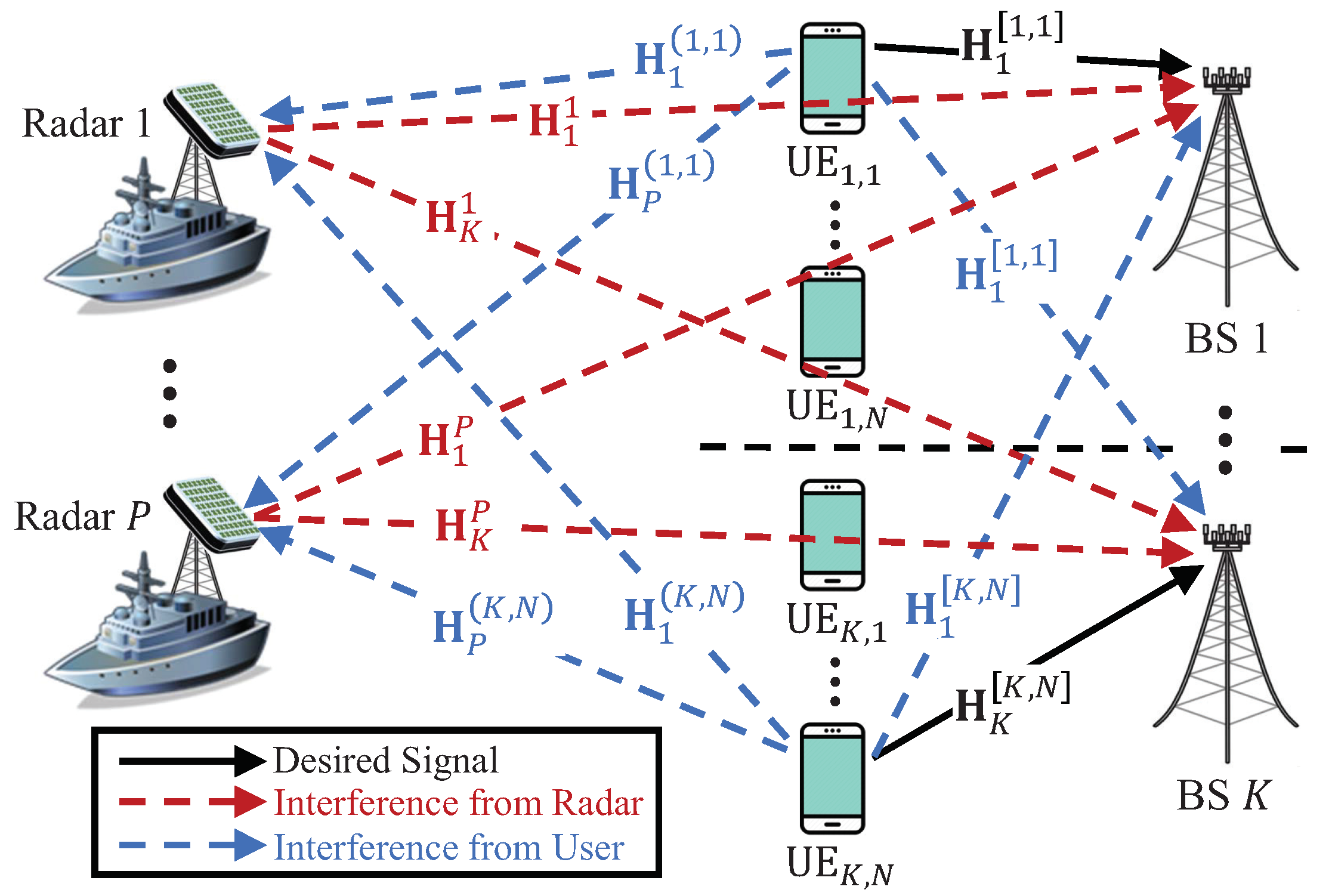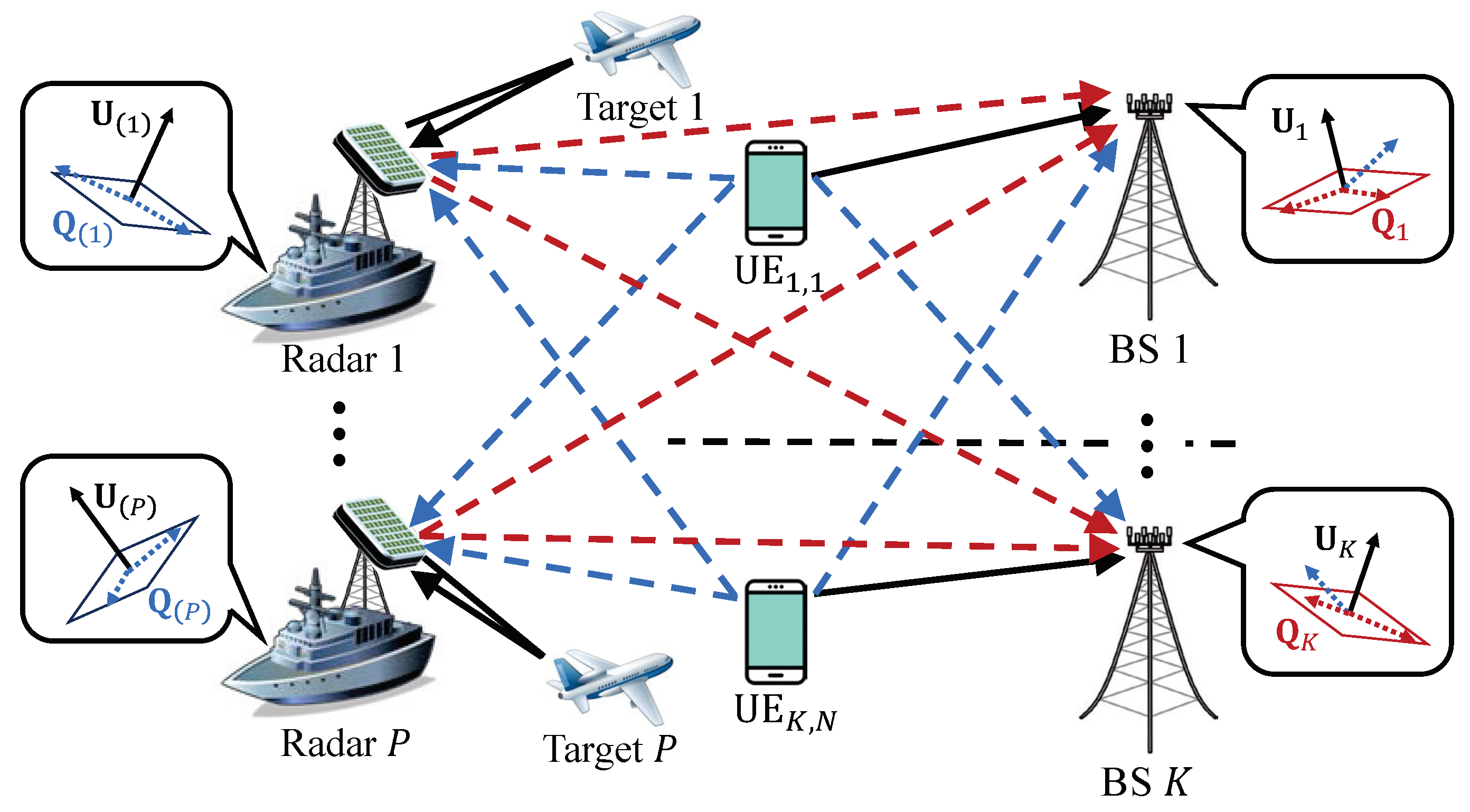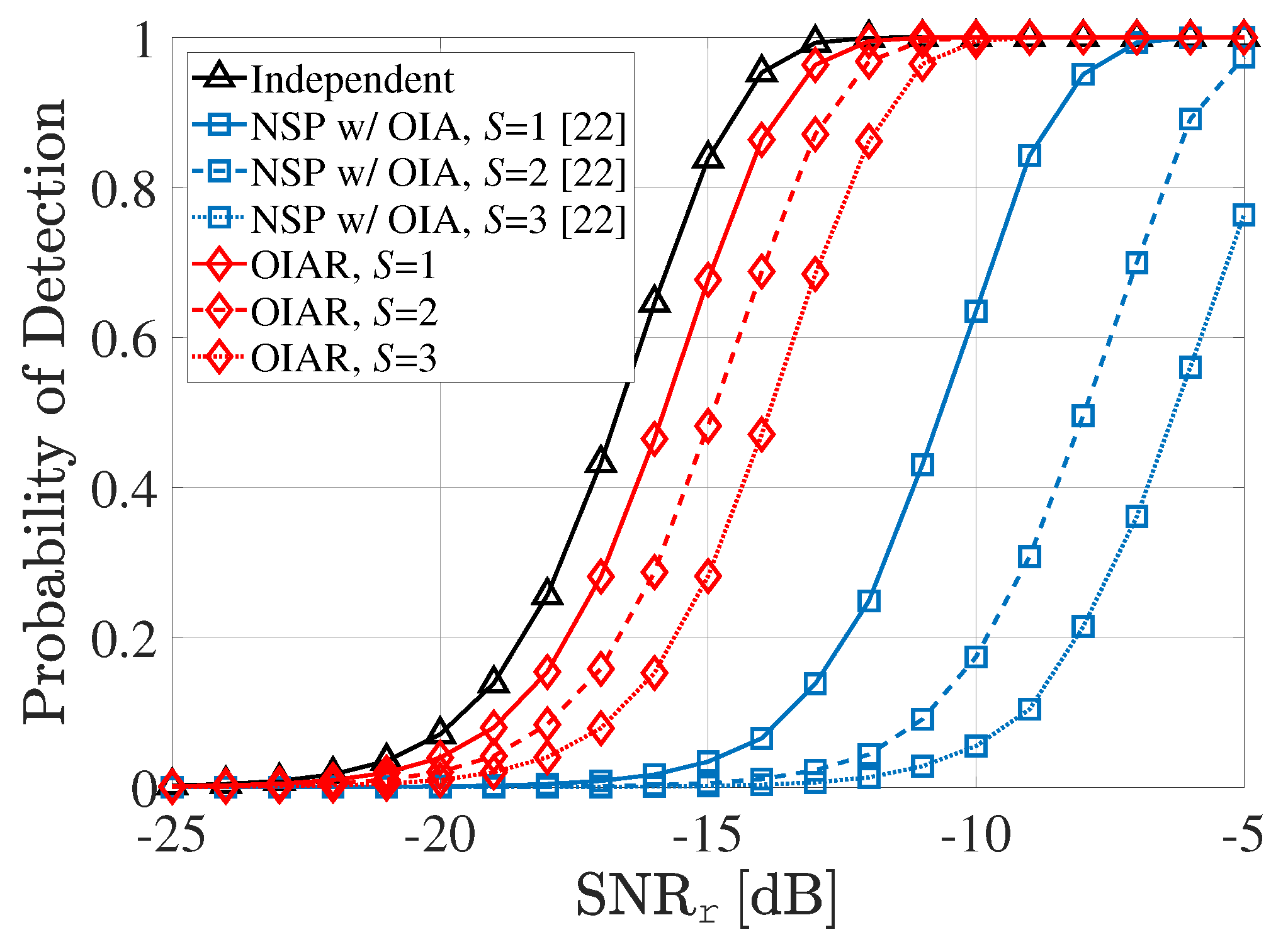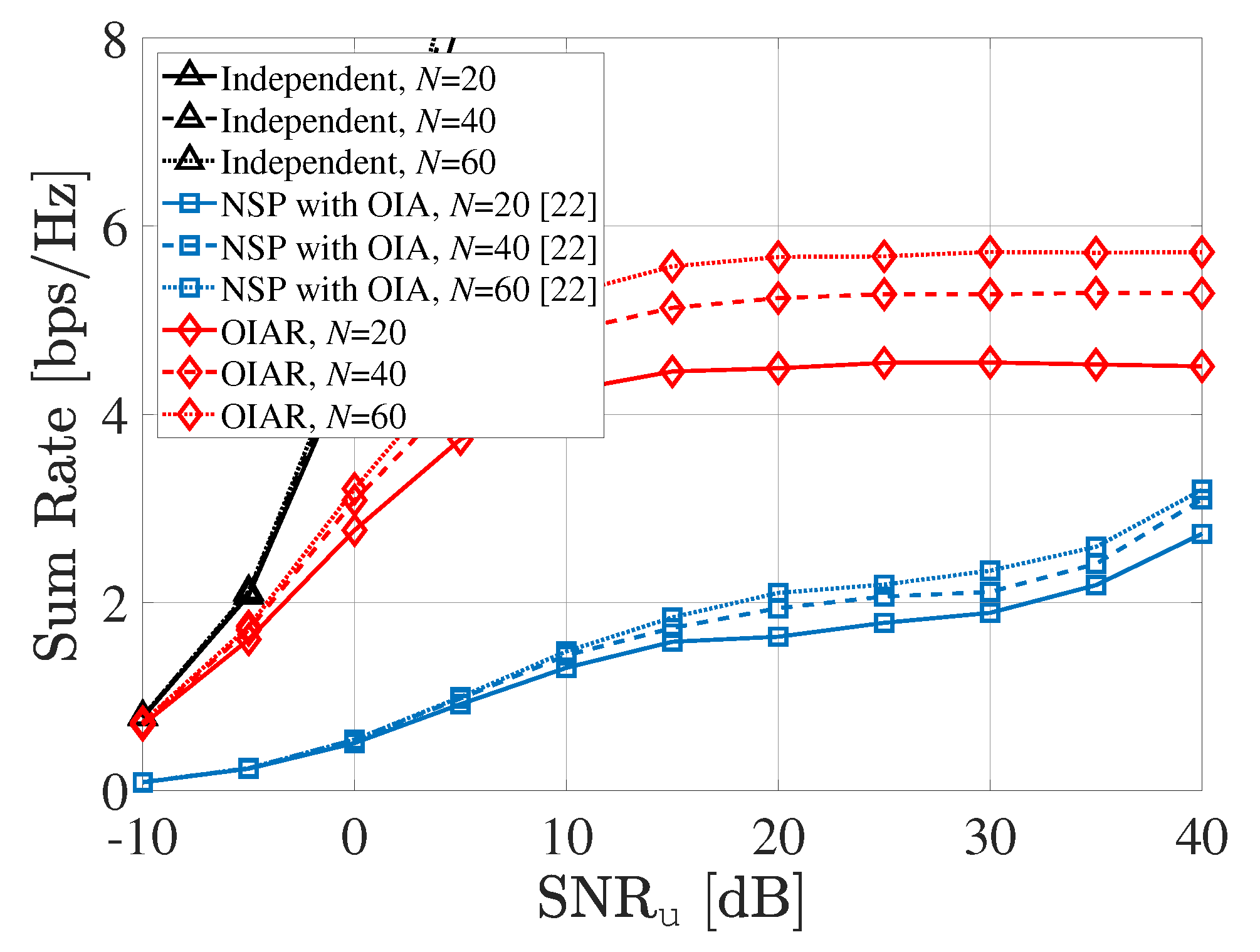Opportunistic Interference Alignment for Spectrum Sharing between Radar and Communication Systems
Abstract
1. Introduction
2. System and Channel Models
3. Opportunistic Interference Alignment with Radar
3.1. Initialization: Separating Signal and Interference Spaces
3.2. Transmit Beamforming
3.2.1. Transmit Beamforming at Communication User Equipments
3.2.2. Transmit Beamforming at Radar Transceivers
3.3. User Scheduling
4. Performance Metrics: Sum-Rate and Target Detection Probability
4.1. Sum-Rate for Communication Systems
4.2. Detection Probability for Radar Systems
5. Numerical Results
6. Conclusions
Author Contributions
Funding
Conflicts of Interest
References
- Haykin, S. Cognitive radio: Brain-empowered wireless commnications. IEEE J. Sel. Areas Commun. 2005, 23, 201–220. [Google Scholar]
- Kang, M.S.; Jung, B.C.; Sung, D.K.; Choi, W. A pre-whitening scheme in a MIMO-based spectrum-sharing environment. IEEE Commun. Lett. 2008, 12, 831–833. [Google Scholar]
- Han, Y.; Pandharipande, A.; Ting, S.H. Cooperative spectrum sharing via controlled amplify-and-forward relaying. In Proceedings of the 2008 IEEE 19th International Symposium on Personal, Indoor and Mobile Radio Communications (PIMRC), Cannes, France, 31 August–4 September 2008; pp. 1–5. [Google Scholar]
- Jovicic, A.; Viswanath, P. Cognitive radio: An information-theoretic perspective. IEEE Trans. Inf. Theory 2009, 55, 3945–3958. [Google Scholar]
- Han, Y.; Pandharipande, A.; Ting, S.H. Cooperative decode-and-forward relaying for secondary spectrum access. IEEE Trans. Wireless Commun. 2009, 8, 4945–4950. [Google Scholar]
- Ban, T.W.; Choi, W.; Jung, B.C.; Sung, D.K. Multi-user diversity in a spectrum sharing system. IEEE Trans. Wireless Commun. 2009, 8, 102–106. [Google Scholar]
- Shin, E.; Kim, D. Time and power allocation for collaborative primary-secondary transmission using superposition coding. IEEE Commun. Lett. 2011, 15, 196–198. [Google Scholar]
- Son, K.; Jung, B.C.; Sung, D.K.; Chong, S. Power allocation policies with full and partial inter-system channel state information cognitive radio networks. Wireless Netw. 2013, 19, 99–113. [Google Scholar]
- Ban, T.W.; Jung, B.C. On the multi-user diversity with fixed power transmission in cognitive radio networks. IEEE Wireless Commun. Lett. 2014, 3, 74–77. [Google Scholar]
- Chang, W.; Jung, B.C. Optimal transmission strategy without capacity loss at a primary user in cognitive radio networks over inter-symbol interference channels. IEEE Commun. Lett. 2014, 18, 411–414. [Google Scholar]
- Verde, F.; Scaglione, A.; Darsena, D.; Gelli, G. An amplify-and-forward scheme for spectrum sharing in cognitive radio channels. IEEE Trans. Wireless Commun. 2015, 14, 5629–5642. [Google Scholar] [CrossRef]
- Chang, W.; Jung, B.C. On the relaying protocols without causing capacity loss at a primary node in cognitive radio networks. IEEE Trans. Veh. Technol. 2016, 65, 5972–5983. [Google Scholar] [CrossRef]
- Lee, W.; Jung, B.C. Pricing-based distributed spectrum access for cognitive radio networks with geolocation database. IET Commun. 2017, 11, 733–738. [Google Scholar]
- Hu, F.; Chen, B.; Zhu, K. Full spectrum sharing in cognitive radio networks toward 5G: A survey. IEEE Access 2018, 6, 15754–15776. [Google Scholar] [CrossRef]
- Jung, B.C.; Lee, W. Performance analysis of opportunistic CSMA schemes in cognitive radio networks. Wireless Netw. 2018, 24, 833–845. [Google Scholar] [CrossRef]
- Lee, S.; Youn, J.; Jung, B.C. A cooperative phase-steering technique with on-off power control for spectrum sharing-based wireless sensor networks. Sensors 2020, 20, 1942. [Google Scholar] [CrossRef]
- Connecting America: The National Broadband Plan. Federal Communications Commission (FCC). 2010. Available online: https://www.fcc.gov/general/national-broadband-plan (accessed on 28 August 2020).
- Realizing the Full Potential of Government-Held Spectrum to Spur Economic Growth. President’s Council of Advisors on Science and Technology (PCAST). 2012. Available online: https://apps.dtic.mil/dtic/tr/fulltext/u2/a565091.pdf (accessed on 28 August 2020).
- Paisana, F.; Miranda, J.P.; Marchetti, N.; DaSilva, L.A. Database-aided sensing for radar bands. In Proceedings of the 2014 IEEE International Symposium on Dynamic Spectrum Access Networks (DYSPAN), McLean, Northern Virginia, 1–4 April 2014; pp. 1–6. [Google Scholar]
- Griffiths, H.; Cohen, L.; Watts, S.; Mokole, E.; Baker, C.; Wicks, M.; Blunt, S. Radar spectrum engineering and management: Technical and regulatory issues. Proc. IEEE 2015, 103, 85–102. [Google Scholar] [CrossRef]
- Khawar, A.; Abdelhadi, A.; Clancy, C. Spectrum sharing between S-band radar and LTE cellular system: A spatial approach. In Proceedings of the 2014 IEEE International Symposium on Dynamic Spectrum Access Networks (DYSPAN), McLean, Northern Virginia, 1–4 April 2014; pp. 7–14. [Google Scholar]
- Khawar, A.; Abdelhadi, A.; Clancy, C. Target detection performance of spectrum sharing MIMO radars. IEEE Sens. J. 2015, 15, 4928–4940. [Google Scholar] [CrossRef]
- Mahal, J.A.; Khawar, A.; Abdelhadi, A.; Clancy, T.C. Spectral coexistence of MIMO radar and MIMO cellular system. IEEE Trans. Aerosp. Electron. Syst. 2017, 53, 655–668. [Google Scholar] [CrossRef]
- Khawar, A.; Abdelhadi, A.; Clancy, T.C. Interference mitigation between seaborne radar and cellular system using 3D channel modeling. In Proceedings of the 2019 International Symposium on Systems Engineering (ISSE), Edinburgh, UK, 1–3 October 2019; pp. 1–4. [Google Scholar]
- Rao, R.M.; Dhillon, H.S.; Marojevic, V.; Reed, J.H. Analysis of worst-case interference in underlay radar-massive MIMO spectrum sharing scenarios. In Proceedings of the 2019 IEEE Global Communications Conference (GLOBECOM), Waikoloa, HI, USA, 9–13 December 2019; pp. 1–6. [Google Scholar]
- Labib, M.; Martone, A.F.; Marojevic, V.; Reed, H.; Zaghloul, A.I. A stochastic optimization approach for spectrum sharing of radar and LTE systems. IEEE Access 2019, 7, 60814–60826. [Google Scholar] [CrossRef]
- Liu, F.; Masouros, C.; Li, A.; Ratnarajah, T. Robust MIMO beamforming for cellular and radar coexistence. IEEE Wireless Commun. Lett. 2017, 6, 374–377. [Google Scholar] [CrossRef]
- Liu, F.; Masouros, C.; Li, A.; Ratnarajah, T.; Zhou, J. MIMO radar and cellular coexistence: A power-efficient approach enabled by interference exploitation. IEEE Trans. Signal Process. 2018, 66, 3681–3695. [Google Scholar] [CrossRef]
- Cadambe, V.R.; Jafar, S.A. Interference alignment and degrees of freedom of the K-user interference channel. IEEE Trans. Inf. Theory 2008, 54, 3425–3441. [Google Scholar] [CrossRef]
- Suh, C.; Tse, D. Interference alignment for cellular networks. In Proceedings of the 2008 46th Annual Allerton Conference on Communication, Control, and Computing, Urbana-Champaign, IL, USA, 23–26 September 2008; pp. 1037–1044. [Google Scholar]
- Jung, B.C.; Shin, W.-Y. Opportunistic interference alignment for interference-limited cellular TDD uplink. IEEE Commun. Lett. 2011, 15, 148–150. [Google Scholar] [CrossRef]
- Jung, B.C.; Park, D.; Shin, W.-Y. Opportunistic interference mitigation achieves optimal degrees-of-freedom in wireless multi-cell uplink networks. IEEE Trans. Commun. 2012, 60, 1935–1944. [Google Scholar] [CrossRef]
- Yang, H.J.; Shin, W.; Jung, B.C.; Paulraj, A. Opportunistic interference alignment for MIMO interfering multiple-access channels. IEEE Trans. Wireless Commun. 2013, 12, 2180–2192. [Google Scholar] [CrossRef]
- Yang, H.J.; Jung, B.C.; Shin, W.; Paulraj, A. Codebook-based opportunistic interference alignment. IEEE Trans. Signal Process. 2014, 62, 2922–2937. [Google Scholar] [CrossRef][Green Version]
- Jin, H.; Jeon, S.; Jung, B.C. Opportunistic interference alignment for random access networks. IEEE Trans. Veh. Tech. 2015, 64, 5947–5954. [Google Scholar] [CrossRef][Green Version]
- Yang, H.J.; Shin, W.-Y.; Jung, B.C.; Suh, C.; Paulraj, A. Opportunistic downlink interference alignment for multi-cell MIMO networks. IEEE Trans. Wireless Commun. 2017, 16, 1533–1548. [Google Scholar] [CrossRef]
- Jung, B.C.; Kim, S.M.; Shin, W.-Y.; Yang, H.J. Optimal multiuser diversity in multi-cell MIMO uplink networks: User scaling law and beamforming design. Entropy 2017, 19, 393. [Google Scholar] [CrossRef]
- Youn, J.; Kim, Y.; Jang, H.S.; Jung, B.C. Downlink interference alignment with multi-user and multi-beam diversity for fog RANs. In Proceedings of the 2019 IEEE 90th Vehicular Technology Conference (VTC2019-Fall), Honolulu, HI, USA, 22–25 September 2019; pp. 1–5. [Google Scholar]
- Cui, Y.; Koivunen, V.; Jing, X. Interference alignment based spectrum sharing for MIMO radar and communication systems. In Proceedings of the 2018 IEEE 19th International Workshop on Signal Processing Advances in Wireless Communications (SPAWC), Kalamata, Greece, 25–28 June 2018; pp. 1–5. [Google Scholar]
- Rihan, M.; Huang, L. Optimum co-design of spectrum sharing between MIMO radar and MIMO communication systems: An interference alignment approach. IEEE Trans. Veh. Tech. 2018, 67, 11667–11680. [Google Scholar] [CrossRef]
- Hong, B.; Wang, W.; Liu, C. Ergodic interference alignment for spectrum sharing radar-communication systems. IEEE Trans. Veh. Tech. 2019, 68, 9785–9796. [Google Scholar] [CrossRef]
- Fortunati, S.; Sanguinetti, L.; Gini, F.; Greco, M.S.; Himed, B. Massive MIMO radar for target detection. IEEE Trans. Signal Process. 2020, 68, 859–871. [Google Scholar] [CrossRef]








© 2020 by the authors. Licensee MDPI, Basel, Switzerland. This article is an open access article distributed under the terms and conditions of the Creative Commons Attribution (CC BY) license (http://creativecommons.org/licenses/by/4.0/).
Share and Cite
Kim, D.-H.; Youn, J.; Jung, B.C. Opportunistic Interference Alignment for Spectrum Sharing between Radar and Communication Systems. Sensors 2020, 20, 4868. https://doi.org/10.3390/s20174868
Kim D-H, Youn J, Jung BC. Opportunistic Interference Alignment for Spectrum Sharing between Radar and Communication Systems. Sensors. 2020; 20(17):4868. https://doi.org/10.3390/s20174868
Chicago/Turabian StyleKim, Dong-Hwan, Janghyuk Youn, and Bang Chul Jung. 2020. "Opportunistic Interference Alignment for Spectrum Sharing between Radar and Communication Systems" Sensors 20, no. 17: 4868. https://doi.org/10.3390/s20174868
APA StyleKim, D.-H., Youn, J., & Jung, B. C. (2020). Opportunistic Interference Alignment for Spectrum Sharing between Radar and Communication Systems. Sensors, 20(17), 4868. https://doi.org/10.3390/s20174868





